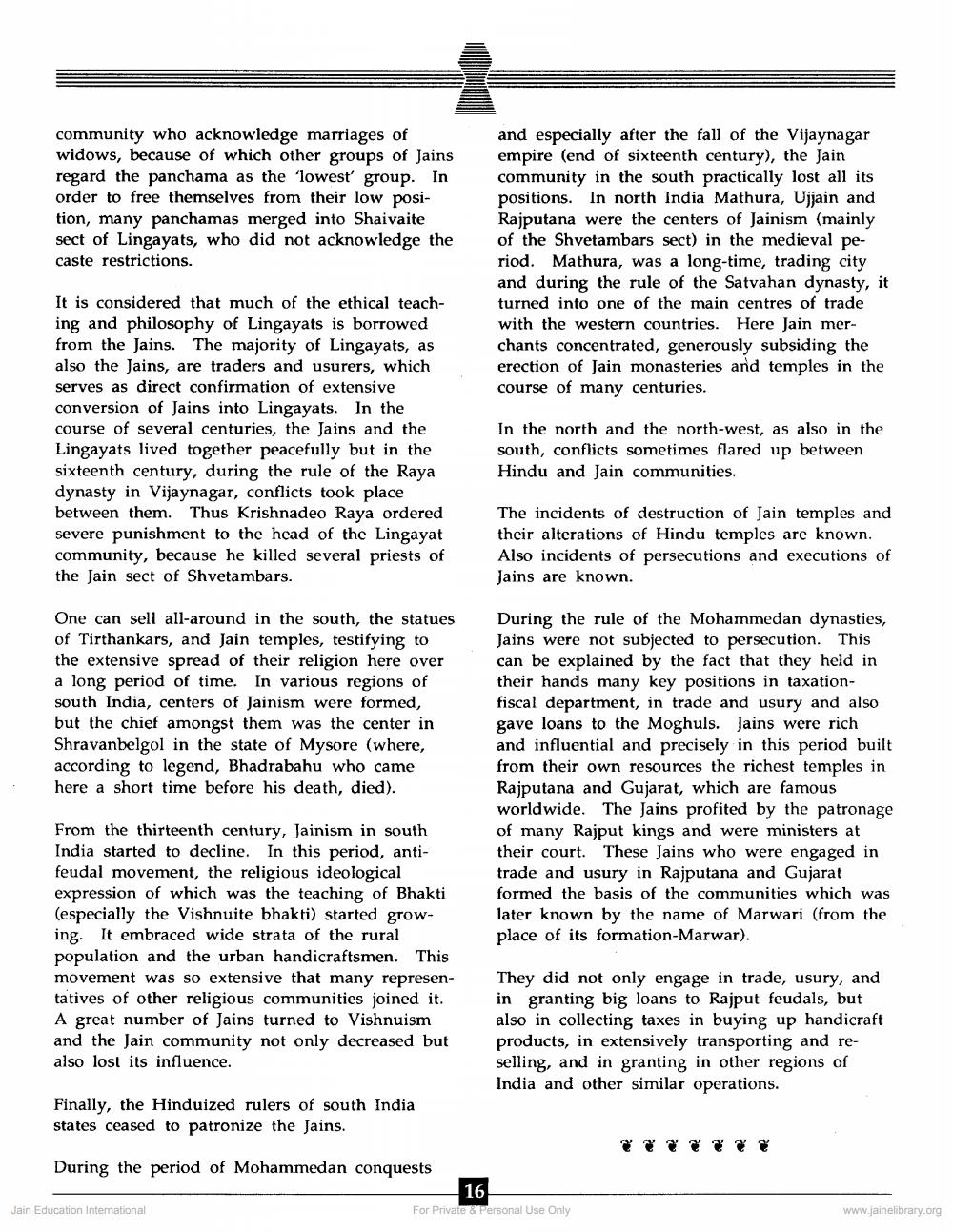________________
community who acknowledge marriages of widows, because of which other groups of Jains regard the panchama as the 'lowest' group. In order to free themselves from their low position, many panchamas merged into Shaivaite sect of Lingayats, who did not acknowledge the caste restrictions.
It is considered that much of the ethical teaching and philosophy of Lingayats is borrowed from the Jains. The majority of Lingayats, as also the Jains, are traders and usurers, which serves as direct confirmation of extensive conversion of Jains into Lingayats. In the course of several centuries, the Jains and the Lingayats lived together peacefully but in the sixteenth century, during the rule of the Raya dynasty in Vijaynagar, conflicts took place between them. Thus Krishnadeo Raya ordered severe punishment to the head of the Lingayat community, because he killed several priests of the Jain sect of Shvetambars.
One can sell all-around in the south, the statues of Tirthankars, and Jain temples, testifying to the extensive spread of their religion here over a long period of time. In various regions of south India, centers of Jainism were formed, but the chief amongst them was the center in Shravanbelgol in the state of Mysore (where, according to legend, Bhadrabahu who came here a short time before his death, died).
From the thirteenth century, Jainism in south India started to decline. In this period, antifeudal movement, the religious ideological expression of which was the teaching of Bhakti (especially the Vishnuite bhakti) started growing. It embraced wide strata of the rural population and the urban handicraftsmen. This movement was so extensive that many representatives of other religious communities joined it. A great number of Jains turned to Vishnuism and the Jain community not only decreased but also lost its influence.
Finally, the Hinduized rulers of south India states ceased to patronize the Jains.
During the period of Mohammedan conquests
Jain Education Intemational
and especially after the fall of the Vijaynagar empire (end of sixteenth century), the Jain community in the south practically lost all its positions. In north India Mathura, Ujjain and Rajputana were the centers of Jainism (mainly of the Shvetambars sect) in the medieval period. Mathura, was a long-time, trading city and during the rule of the Satvahan dynasty, it turned into one of the main centres of trade with the western countries. Here Jain mer
chants concentrated, generously subsiding the erection of Jain monasteries and temples in the course of many centuries.
In the north and the north-west, as also in the south, conflicts sometimes flared up between Hindu and Jain communities.
The incidents of destruction of Jain temples and their alterations of Hindu temples are known. Also incidents of persecutions and executions of Jains are known.
During the rule of the Mohammedan dynasties, Jains were not subjected to persecution. This can be explained by the fact that they held in their hands many key positions in taxationfiscal department, in trade and usury and also gave loans to the Moghuls. Jains were rich and influential and precisely in this period built from their own resources the richest temples in Rajputana and Gujarat, which are famous worldwide. The Jains profited by the patronage of many Rajput kings and were ministers at their court. These Jains who were engaged in trade and usury in Rajputana and Gujarat formed the basis of the communities which was later known by the name of Marwari (from the place of its formation-Marwar).
They did not only engage in trade, usury, and in granting big loans to Rajput feudals, but also in collecting taxes in buying up handicraft products, in extensively transporting and reselling, and in granting in other regions of India and other similar operations.
16
For Private & Personal Use Only
www.jainelibrary.org




